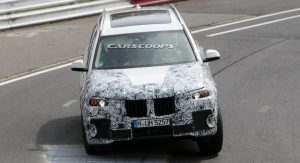Just because the X7 will be BMW‘s largest ever SUV, doesn’t mean the Bavarian automaker will let it disappoint its future owners in terms of handling.
Hence these tests it’s undergoing at the Nurburgring, a place where don’t normally expect to find large seven-seater models such as the X7.
Yet, underneath all that camouflage lies a stretched version of BMW’s CLAR platform, which has already been deployed in service of the new 7- and 5-series models, and will eventually underpin the all-new X5 and even 3-Series in the near future.
The fact that the upcoming X7 will feature three rows of seats and will have over 5 meters in length means that it should prove a particularly attractive proposition for both U.S. as well as Chinese buyers. Once it hits showrooms, the X7 is expected to rival the likes of the Mercedes-Benz GLS or the Range Rover, but something like a Lincoln Navigator as well.
Powering the X7 should be a range of both petrol as well as diesel units (depending on market), with a four-cylinder version a possibility, but only in PHEV form. According to AMS, the X7 could get the new twin-turbo V8 that’s set to debut in the next BMW M5, which in turn could be used for an X7 M model, if BMW’s interested in challenging the Mercedes-AMG GLS 63 directly.
As for looks and tech, we expect the X7 to differ from the X5, though not significantly. It should however feature all the latest on-board gadgets currently available in the 7-Series and 5-Series models – which it turn would make it one of the most technologically advanced full-size SUVs in the world.
The new BMW X7 is expected to arrive sometime next year, with prices starting at around €100,000 (over $100,000).
Photo Credits: CarPix for CarScoops













